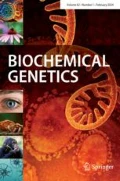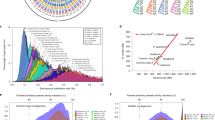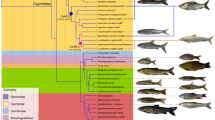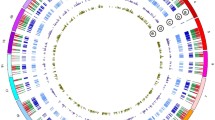Abstract
Botia macracantha and B. modesta have been demonstrated to be tetraploid species on the basis of their karyotypes and on the basis of the expression of a number of isozymes encoded by duplicate loci. A rather low percentage of duplicate loci was detected by electrophoresis, compared to that for other tetraploid Cypriniformes. Several hypotheses have been advanced to account for the low levels of duplicate gene expression observed. Lastly, many of the duplicate loci have diverged to unique patterns of expressions in different tissues or different levels of activity within a single tissue.
Similar content being viewed by others
References
Avise, J., and Ayala, F. (1976). Genetic differentiation in speciose versus depauperate phylads: Evidence from the California minnows. Evolution 3046.
Bailey, G., Wilson, A., Halver, J., and Johnson, C. (1970). Multiple forms of malate dehydrogenase in salmonid fishes. J. Biol. Chem. 2455927.
Bender, K., and Ohno, S. (1968). Duplication of the autosomally inherited 6-phosphogluconate dehydrogenase locus in tetraploid species of cyprinid fish, Biochem. Genet. 2101.
Bernstein, S., Throckmorton, L., and Hubby, J. (1973). Still more genetic variability in natural populations. Proc. Natl. Acad. Sci. 703928.
Brewer, G. (1970). An Introduction to Isozyme Techniques, Academic Press, New York.
Britten, R., and Davidson, E. (1971). Repetitive and non-repetitive DNA sequences and a speculation on the origins of evolutionary novelty. Q. Rev. Biol. 46111.
Engel, W., Schmidtke, J., and Wolf, U. (1975). Diploid-tetraploid relationships in teleostean fishes. In Markert, C. L. (ed.), Isozymes, Vol. IV: Genetics and Evolution, Academic Press, New York, p. 449.
Ferris, S., and Whitt, G. (1977). Loss of duplicate gene expression after polyploidization. Nature 265258.
Hinegardner, R. (1976). Evolution of genome size. In Ayala, F. J. (ed.), Molecular Evolution, Sinauer, Sunderland, Mass.
Hitosumachi, S., Sasaki, M., and Ojima, Y. (1969). A comparative karyotype study in several species of Japanese loaches (Pisces, Cobitidae). Japan J. Genet. 44157.
Holmes, R., and Markert, C. (1969). Immunochemical homologies among subunits of trout lactate dehydrogenase isozymes. Proc. Natl. Acad. Sci. 64205.
Johnson, G. (1976). Hidden alleles at the α-glycerophosphate dehydrogenase locus in Colias butterflies. Genetics 83149.
Klose, J., Wolf, U., Hitzeroth, H., Ritter, H., Atkin, N., and Ohno, S. (1968). Duplication of the LDH gene loci by polyploidization in the fish order Clupeiformes. Humangenetik 5190.
Markert, C., Shaklee, J., and Whitt, G. (1975). Evolution of a gene. Science 189102.
Nablant, T. (1963). A study of the genera of Botiinae and Cobitinae (Pisces, Ostariophysi, Cobitidae). Trav. Mus. Hist. Nat. ‘Grigore Antipa’ Buchares 4343.
Nei, M. (1972). Genetic distance between populations. Am. Nat. 106283.
Ohno, S. (1970). Evolution by Gene Duplication, Springer-Verlag, New York.
Ohno, S. (1974). Protochordata, Cyclostomata and Pisces, Gebrüder-Borntraeger, Stuttgart.
Ohno, S., Muramoto, J., and Christian, L. (1967). Diploid-tetraploid relationships among Old World members of the fish family Cyprinidae. Chromosoma 231.
Pardue, M., and Gall, J. (1970). Chromosomal localization of mouse satellite DNA. Science 1681356.
Powers, D., and Edmundson, A. (1972). Multiple hemoglobins of catostomid fish II. The amino acid sequence of the major α-chain from Catostomus clarkii. J. Biol. Chem. 2476694.
Sackler, M. (1966). Xanthine oxidase from liver and duodenum of the rat: Histochemical localization and electrophoretic heterogeneity. J. Histochem. Cytochem. 14326.
Sarich, V. (1977). Rates, sample sizes, and the neutrality hypothesis for electrophoresis in evolutionary studies. Nature 26524.
Schmidtke, J., and Engel, W. (1975). Gene action in fish of tetraploid origin. 1. Cellular and biochemical parameters in cyprinid fish. Biochem. Genet. 1345.
Shaklee, J., Kepes, K., and Whitt, G. (1973). Specialized lactate dehydrogenase isozymes: The molecular and genetic basis for the unique eye and liver LDH's of teleost fishes. J. Exp. Zool. 185217.
Shaw, C., and Prasad, R. (1970). Starch gel electrophoresis of enzymes—A compilation of recipes. Biochem. Genet. 4297.
Stock, A., Burnham, D., and Hsu, T. (1972). Giemsa banding of meiotic chromosomes with a description of a procedure for cytological preparations from solid tissues. Cytogenetics 11534.
Taki, Y. (1974). Fishes of the Lao Mekong Basin, U.S. Agency for International Development Mission to Laos, Agriculture Division.
Uyeno, T., and Smith, G. (1972). Tetraploid origin of the karyotype of catostomid fishes. Science 175644.
Whitt, G. (1970). Developmental genetics of the lactate dehydrogenase isozymes of fish. J. exp. Zool. 1751.
Wilson, F., Whitt, G., and Prosser, C. (1973). Lactate dehydrogenase and malate dehydrogenase isozyme patterns in tissues of temperature acclimated goldfish (Carassius auratus). Comp. Biochem. Physiol 46B105.
Wolf, U., Ritter, H., Atkin, N., and Ohno, S. (1969). Polyploidization in the fish family Cyprinidae, order Cypriniformes. I. DNA content and chromosome sets in various species of Cyprinidae. Humangenetik 7240.
Author information
Authors and Affiliations
Additional information
This research was supported by NSF PCM 76-08383 grant to G. S. W. and an NIH Cell Biology Traineeship to S. D. F.
Rights and permissions
About this article
Cite this article
Ferris, S.D., Whitt, G.S. Duplicate gene expression in diploid and tetraploid loaches (Cypriniformes, Cobitidae). Biochem Genet 15, 1097–1112 (1977). https://doi.org/10.1007/BF00484500
Received:
Accepted:
Issue Date:
DOI: https://doi.org/10.1007/BF00484500




